
The Vinnie Rossi Brama Integrated Amp slipped, gracefully, onto my list of Favorite Amplifiers soon after it arrived.
The Brama also jumped to the tippy top of my short list of favorites where just a few others reside. And even here, the Brama’s graceful sound, looks, fit, finish, and feel make it a standout as a complete package, a luxury product that delivers the sonic goods.
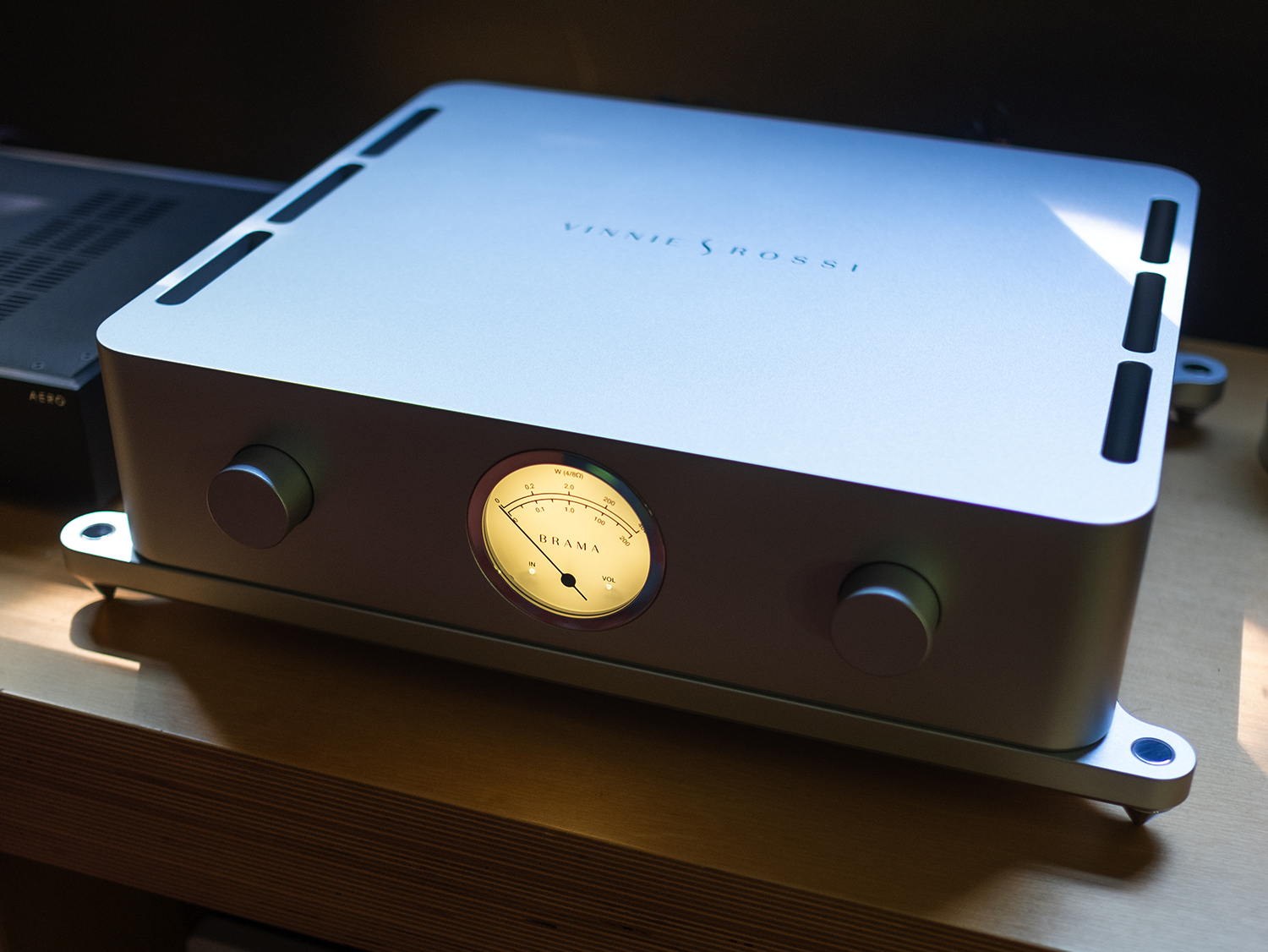
The Brama Integrated Amplifier, officially Gen 2, offers 200 Watts of output power into 8 Ohms, 400 Watts into 4 Ohms, and “unconditional stability into 2 Ohms” from its Class AB lateral MOSFET output stage. A pair of Western Electric 300Bs sit inside, mounted horizontally, as part of the pure Class A preamplifier stage. Don’t worry about what you may be worrying about as those 300Bs are run very conservatively and the Brama’s chassis is machined from a solid chunk of aluminum which acts like a giant heat sink. Plus, there’s a protection circuit with 3 sensors keeping an eye on the Brama’s temperature.
Here’s some words on the Brama power supply from Vinnie Rossi:
The Brama Integrated Amplifier boasts a custom switch-mode power supply designed from the ground up to outperform conventional linear supplies. With 2400W peak output power and patented Belleson linear super-regulated outputs, it delivers high current with exceptionally low output noise and impedance. Its high-speed operation and low magnetic losses ensure ultra-fast transient response and superior pace, rhythm, and timing in music reproduction.
With active power factor correction (PFC) and superior regulation and stability, the power supply ensures maximum performance regardless of AC mains quality. Housed in a fully enclosed compartment precision machined into Brama’s solid aluminum body, it is fully grounded and isolated from the audio circuitry, performing like a highly-responsive, well-tuned engine.
While I’m aware of many online experts, the kind of experts who have never designed or built anything, who are nonetheless certain linear power supplies are always the better choice, I’m inclined to listen to people who actually design and build things and let the finished product speak for itself. Crazy, I know.
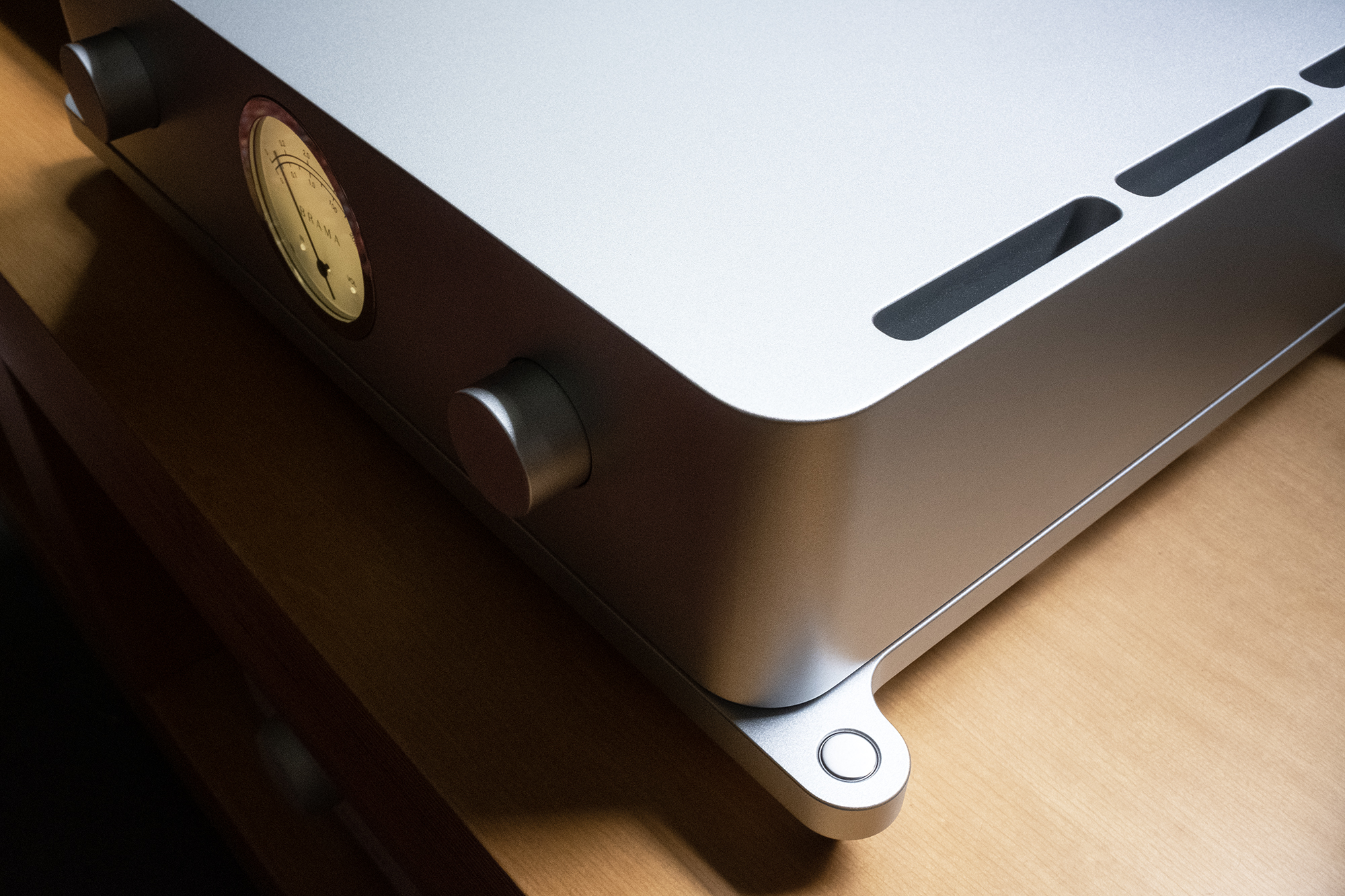
Brama’s industrial design is the product of Olivier Raymond Studio whose clients include Samsung, Porsche AG, and Vitra, and the Brama’s cool understated elegance more than tickles my fancy. The front face is a study in simple symmetry with a pair of silky smooth controls sitting on either side of that lovely Sapphire crystal gauge that does more than dance to the music as it also shows the selected input when changing inputs as well as the volume level when moving it up or down. It’s a smart meter. The left control is a 24-position Swiss rotary encoder with magnetic sensing for input selection and when pushed on/off, while the right control offers 48-positions for volume control and when pushed, mute.
From Vinnie Rossi:
The reason for the 48-positions is because there are 100 volume steps, so I wanted more fine mechanical “steps” when you rotate the volume knob. The input select only has 5 selections, so the 24-step version of that part seemed to feel better.
I will note that those control knobs get warm to the touch but that’s just aluminum doing its heat dissipation thing while also imparting a living being feel to otherwise cold metal.

I know some audiophiles poo poo on caring about how things look but I dismiss that silly nonsense as sad silly nonsense.

The Brama offers 5 balanced XLR inputs (RCA-to-XLR adapters included and installed in Input 2 here), 1 volume-controlled balanced XLR output, a pair of WBT Nextgen 0710-Ag binding posts (I like these), a USB-C jack for firmware updates, a Brama Link for interfacing with Brama Monoblock Power Amplifiers , and an IEC inlet for power.
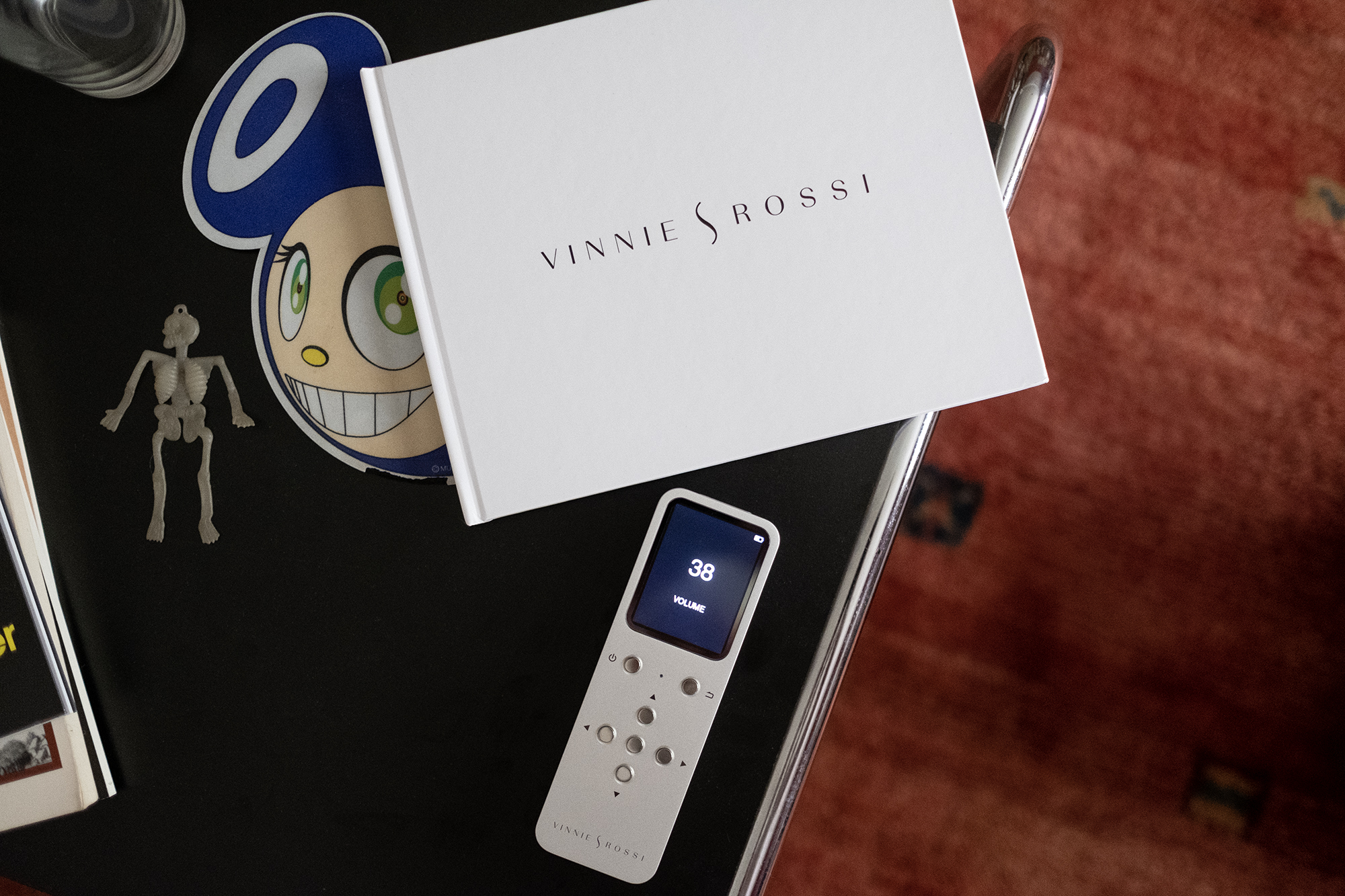
The included remote, which speaks to the Brama via Bluetooth, is also machined from a single slab-O-aluminum and houses a 2.4”, 240×320 pixel TFT high-resolution liquid crystal display (LCD) while holding the distinction of being among the most intelligent remotes I’ve come across as it includes a Power-Saver Mode that puts the screen to sleep after 60 seconds of inactivity. When in ‘power-saver mode’ the screen is not lit but you can still use the remote as is or wake it back up with the press of the BACK button. After 10 minutes of inactivity, the remote turns off but a quick press of the Power button turns it back on. Battery icon in the upper right corner of the screen flashes when the remote is need of a recharge. It’s a smart remote.
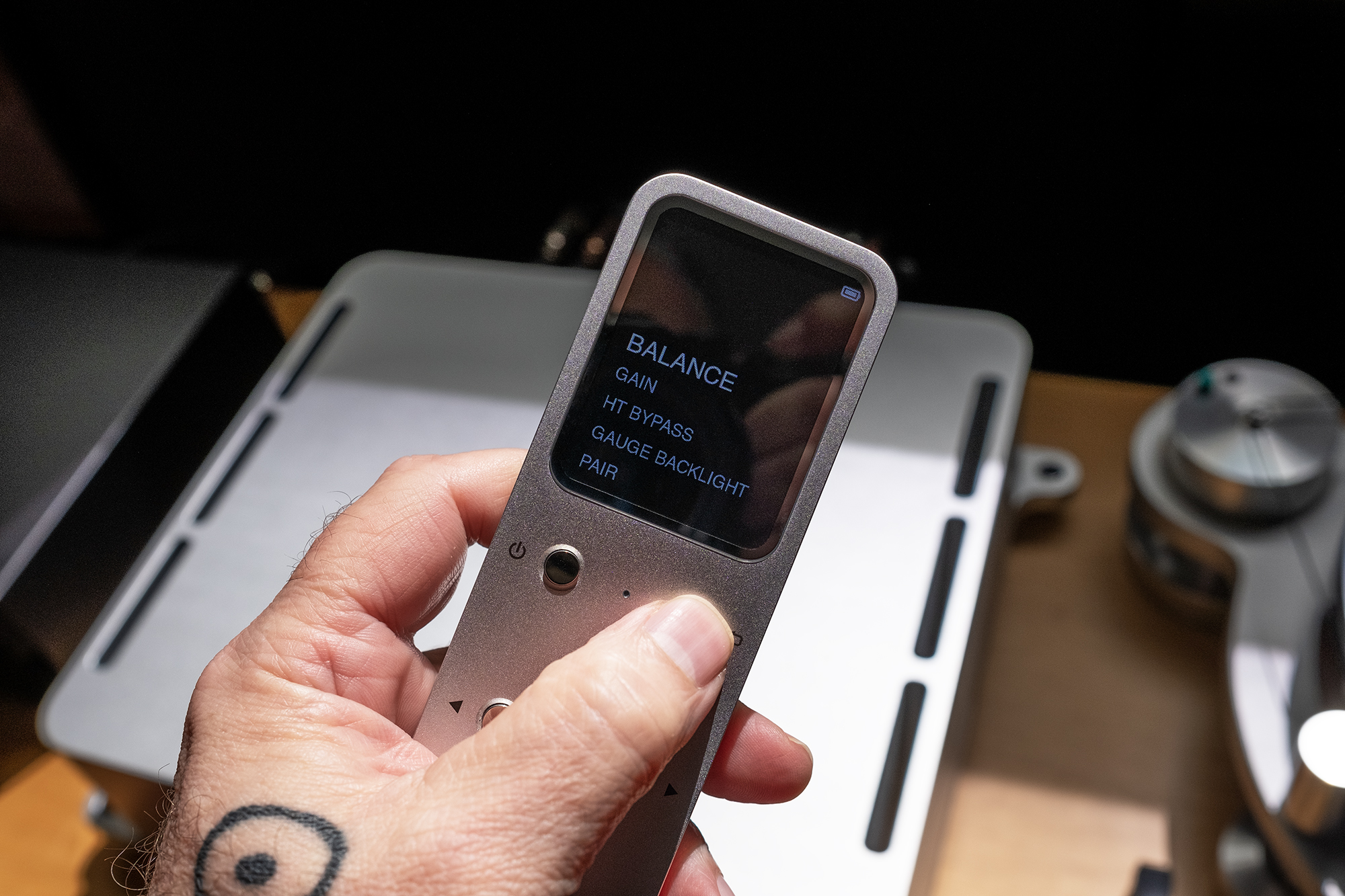
The Brama remote allows you to set channel Balance, select one of three Gain levels (Low, Medium, and High), enter/exit Home Theater Bypass Mode (bypasses all preamp and volume control circuitry), turn off the backlight that lovely Sapphire crystal gauge (why-O-why would anyone want to do that!), adjust the volume, select the input, turn the power on/off, and mute.
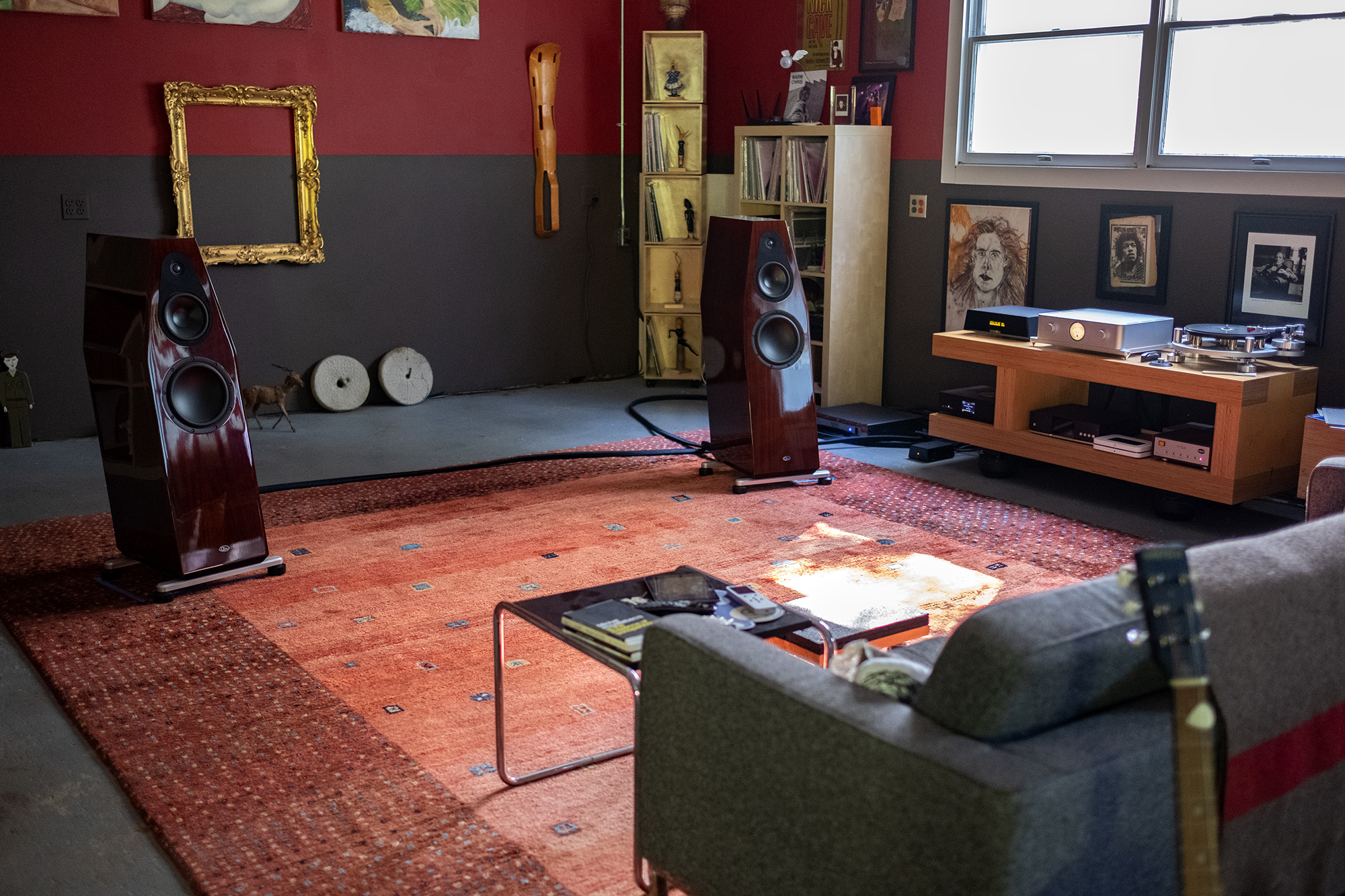
I mainly paired the Brama with the review Qln Reference 9 Loudspeakers (more info), but I also gave it a good run with the Barn resident DeVore O/96 (review). The digital front end consisted of the now barn resident Grimm MU1 (review) feeding the resident totaldac d1-unity (review) with a length of AudioQuest Diamond AES cable (see full barn and system details).

And let me just say that as a system, the Grimm > totaldac > Brama > Qln setup delivered some of the most engaging music I’ve had the pleasure to live with in Barn. The kind of engagement that made me want to listen more. And more. There’s a finely resolved ease to the sound of the Brama that doesn’t trade resolution for warmth but rather offers grace and delicacy that makes the Brama’s performance stand out from the competition. And I will add that living with the Brama, seeing and using it over the coarse of its nearly 2-month Barn stay only served to add to my enjoyment of its refined and graceful appearance and fine, oh so fine, fit ‘n feel. The total package.
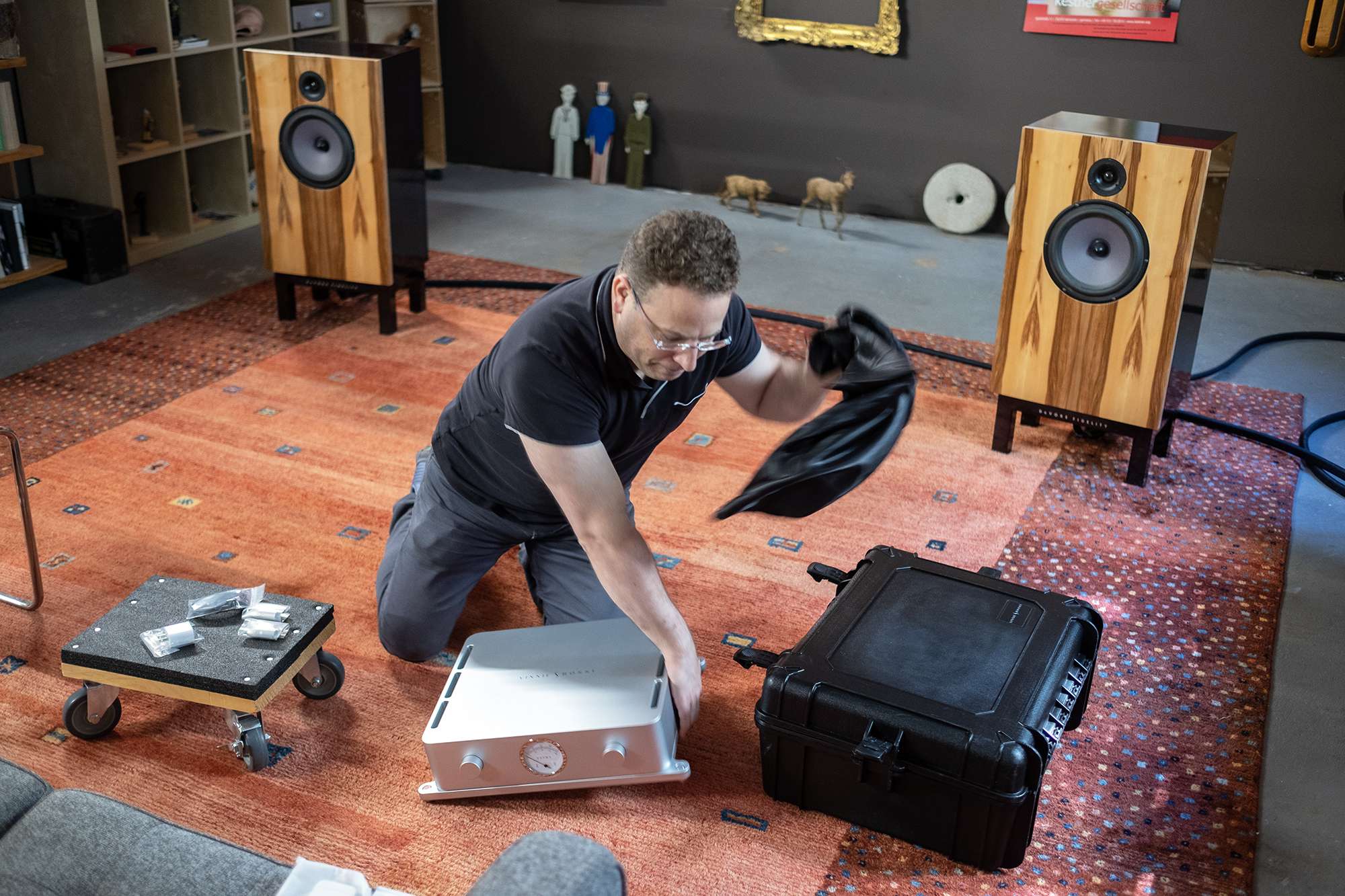
I will also add that I first reviewed a Vinnie Rossi designed piece of kit back, way back, in 2005. That’s Vinnie hard at work removing the Brama from its included flight case. A flight case is another user friendly and very nice touch.
Eyeline by Brooklyn-based LEYA “…is a mixtape we started in mid-November while on tour. It is not our new record. We recorded it mostly at home and asked friends to contribute. It is of the origin of sight, like seeing the one who is watching, an imperfect parade for charmed constellations.” Featuring guest spots by claire rousay, Eartheater, Julie Byrne, and more plus a “Dankworld Remix” by Actress, Eyeline is an ethereal vocals and harp-led trip and treat. Big, billowy clouds of sound rolled out of the Qln speakers, as soft as the instrumentation demanded while vocals from Okay Kaya floated above on “Win Some” filling the Barn’s A-side and me with wanderlust while firmly planted on the comfy Knoll (knockoff) couch.
Music as travel may be cliché but this music played through this system inspired the kind of out of body, forget the present experience that I long for. A leave the phone alone kind of attention to just the music and the traces of places it leads, which can be different with each listen. To my mind, this is one of music’s greatest strengths—complete sensual and intellectual connection—and in my experience the more believably natural the hifi’s way with reproduction, the further and deeper we get to go. The Brama plumbs depths.
Supergroups come in all shapes and sizes and Beings are one such incarnation. Featuring Zoh Amba (saxophone, vocals, acoustic guitar, harmonium, piano), Steve Gunn (electric guitar), Shahzad Ismaily (bass, synth), and Jim White (drums), There Is A Garden is their debut, released by No Quarter back in June. These are ‘avant garde’ musicians playing free (improvised) jazz with more than a touch of psych and song thrown in, all adding up to a wild and dextrous ride.
To my ears, this is friendly difficult music, friendly in that it’s a descendant of some of my favorite not easy listening from Albert Ayler, Sonny Sharrock, and Last Exit and difficult descendants are never as difficult as their parents who paved the way. One of the things I love about Beings is each player plays with ease at full throttle, one of their supergroup super powers, bringing There Is A Garden to extreme levels of high octane energy. Timing, breaks, beats, and the voices of each player’s instrument(s) propel the listening experience and the Brama, with help from the Grimm/totaldac dynamic duo and Qln Ref 9s did a stunning job of bringing those voices and rhythms into the Barn with dimensional and timbral purity. A kind of realism that astounds in its ability to reach beyond reproduction by offering what feels like the real thing happening right now. The Brama is a master at fluidity, richness without ever sounding overripe, and dynamic impact that feels right as opposed to overcooked. It is also a completely clean clear silent runner, with absolutely no discernible self-generated interference.

Adding up the Brama’s many talents, perhaps its greatest appeal lies in presenting music as a door already open, without obstruction caused by perceived sonic shortcomings.
Ghost Dubs debut Damaged was released on Kevin Richard Martin’s Pressure label in July. Just adding up these elements—band name, album title, and label—we have most of the clues needed to know what we’re in for. We also know, especially after listening, that Damaged digs down deep and low, and even lower still, with ultra-deep electronic bass forming the bedrock for the glacial movements of Damaged’s 12 tracks. What Damaged also taught me was how easily the Brama delivers deep (deep) bass as something more than sound pressure as played through the Qln 9s and the DeVore O/96. This is music you want to feel as well as hear, thumpy lumpy bass need not apply, and the Brama drove both sets of speakers to earth shakingly dimensional and fully formed and voiced bass depths. Nice.
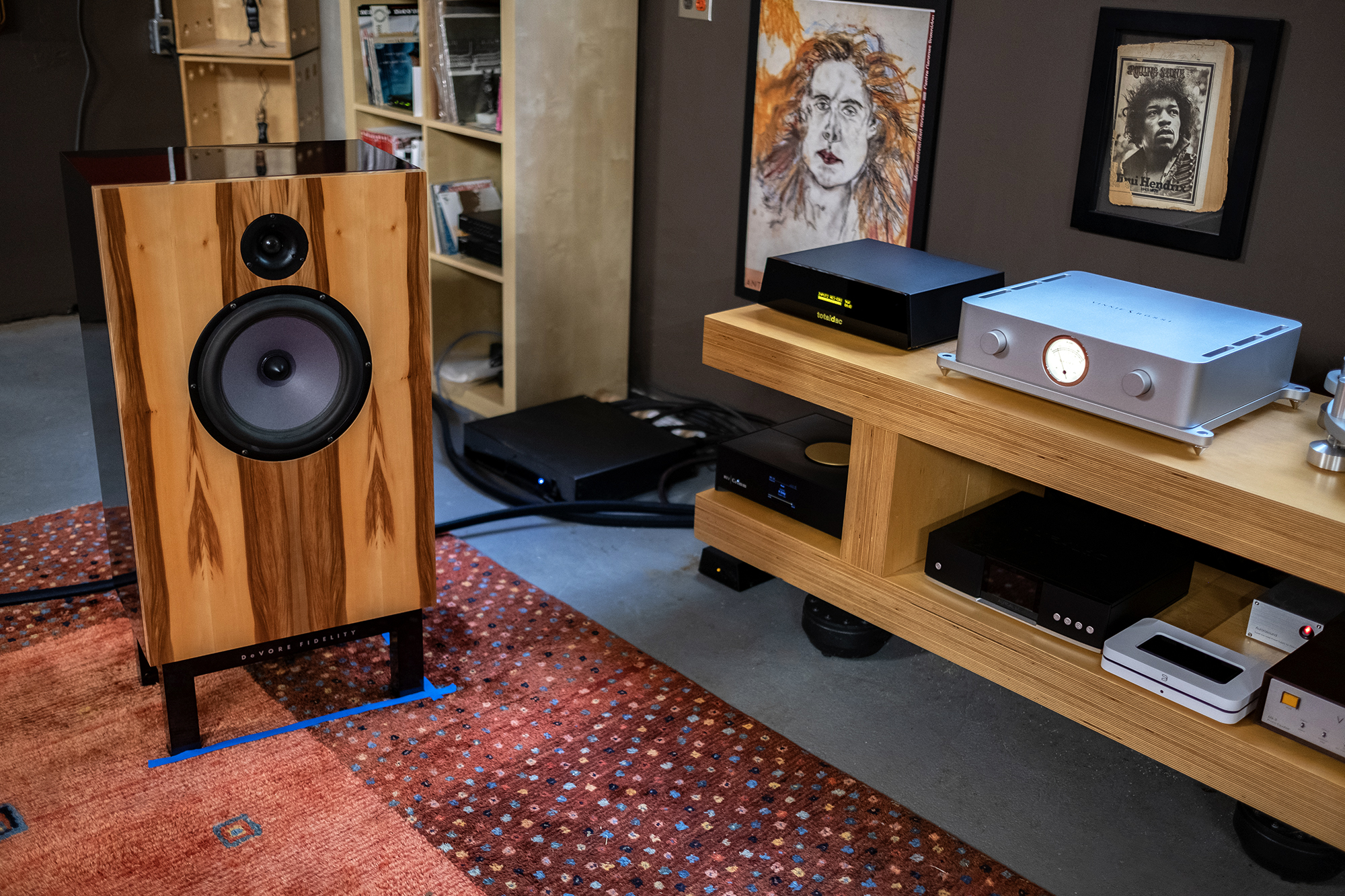
What’s more, there’s plenty of layers on top, dense tightly packed crunches of sound expertly drawn by Stuttgart producer Michael Fiedler as Ghost Dubs that describe the fuller structure, a kind of foreboding post-something bad urban landscape that the Brama seemed designed to portray.
From the liner notes:
If you like your melodies submerged, your dub narcotic, your basslines obese, and your beats evaporating, ‘Damaged’ provides the perfect prescription and entry point into Ghost Dub’s spectral soundworld.
With both sets of speakers, the DeVore O/96 and Qln Reference 9, the Brama reproduced these submerged melodies, narcotic dub, obese basslines, and evaporating beats with a seductive grace, the kind of reproduction that acts as invitation to a deeper and more meaningful experience as compared to some amplifiers that seem to shout music out to get attention. In these terms, I would suggest thinking of the Brama’s way with music as a welcoming gesture as opposed to an off-putting sonic pushing and shoving.
19 Masters from Saya Gray, released on Dirty Hit in June of 2022, has become a test record for all its weird and wonderful sound creatures that exist within, animating this rich music like a pop up book come to life. “Music has always been very much an in body/out of body experience for me.” says Gray and listening through 19 Masters with the Brama leading the DeVore O/96 felt like a walk through an enchanted technicolor sound garden. The Brama is certainly rich-sounding but to my ears and tastes its the right amount of richness as there’s still texture and harmonic rightness as opposed to the over-ripe sound from some tube-based electronics.
I had an opportunity to briefly re-visit with the Riviera Labs AFM25 Monoblock Amplifiers (review) paired with the Qln, which reminded me, almost immediately, of the Riviera gear’s nearly fantastical way with re-creating music’s full 3D form. On the second track from 19 Masters, “I Found a Floorboard under the soil”, the Riviera monoblocks, using the Brama’s pre-out as pre, turned the rich cornucopia of sounds into a more believably dense and dimensional garden as compared to the Brama as integrated amp. I will add that I haven’t heard any electronics that match the Riviera gear in these terms. That being said, the Brama’s many strengths propel music with a compelling, yet different, kind of fascination and wonder.
Acoustic guitar, bass, synths, trumpet, and more with Gray’s vocals twisted this way and that highlighted the Brama’s ability to recreate the full voice of any and all sound sources, acting as fast track to Gray’s rich and imaginative world-O-wonders.
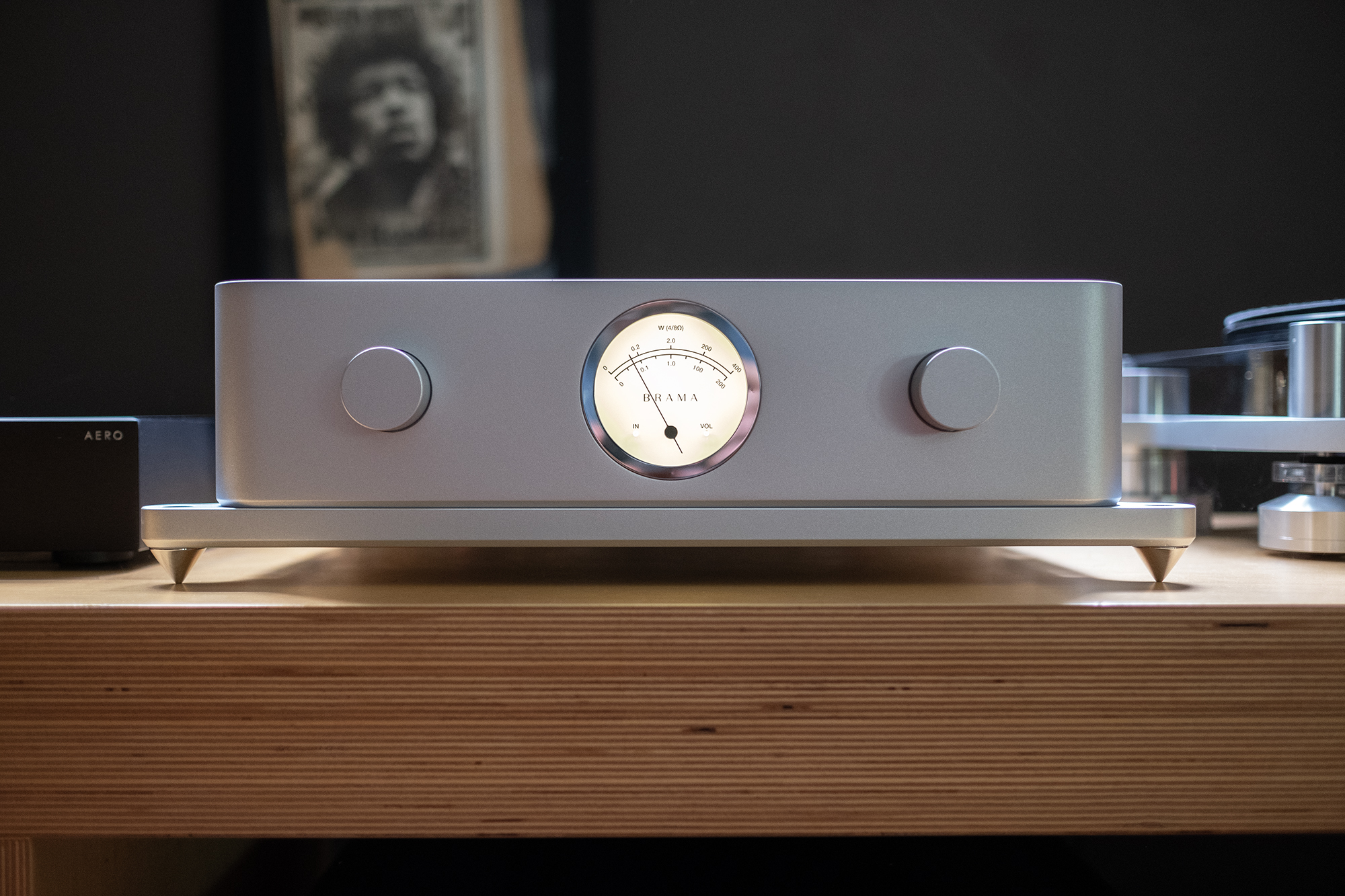
Essences of reproduction are not easy to describe with words. But we try. As is my want, I send lots of music through review gear, some new, some old, and some old favorites used for sussing out comparative qualities of reproduction. And here, the Vinnie Rossi Brama integrated amp declared itself to be among my favorites, admittedly soon after it arrived. The rest of the near 2 months of time spent confirming that early impression and of greater importance, to better understand and hopefully describe its unique way with reproduction.
Chief among the Brama’s strengths are its graceful way with any music you send its way coupled with just-right richness, full range reach, and a kind of effortless purity that invites the listener in, as deeply as one’s time and attention allows. And Vinnie Rossi wrapped all of that sonic goodness in one of the most attractive, thoughtfully designed packages I’ve had the pleasure to live with. All told, the Vinnie Rossi Brama Integrated Amplifier comes with my highest recommendation. Bravo!
Vinnie Rossi BRAMA Integrated Amplifier
Price: $47,995
Company Website: Vinnie Rossi
Features
Controls
- Volume Control: 100-step precision resistor ladder topology
- Input Select: Choose from 5 inputs
- Gain: Low/Med/High settings
- Balance: 12-step adjustment from left to right
- Memory Inputs: Save settings for Gain and Balance per input
- Home Theater Bypass Mode: Easily switch to this mode
Front Panel
- Left Knob: 24-position Swiss rotary encoder with magnetic sensing; push-button for power ON/OFF
- Right Knob: 48-position Swiss rotary encoder with magnetic sensing; push-button for MUTE.
- Wattage Gauge: Displays RMS watts into 8/4 ohms
- Gauge Glass: Sapphire crystal
Rear Panel
- Line-Level Inputs: 5 sets of balanced XLR inputs (RCA-to-XLR adapters included)
- Line-Level Outputs: 1 set of volume-controlled balanced XLR outputs
- Speaker Outputs: WBT Nextgen 0710-Ag binding posts
- AC Input Jack: IEC 320-C14 with built-in fuse holder
- USB-C Jack: For firmware updates
- Brama Link: 1 pair for interfacing with Brama Monoblock Power Amplifiers or for trigger output usage.
Remote
- Display: 2.4” high-resolution LCD with sapphire glass
- Connectivity: Bluetooth connection to Brama
- Battery: 3.7V Li-ion rechargeable (user-replaceable)
- Charging: USB-C jack for battery charging and firmware updates
- Material: Machined from a solid block of aluminum
Protection
- Over-Current Protection: For L and R power amplifier outputs
- Over-Temperature Protection: Monitored by 3 sensors
- Alarm Reporting: Automatic reporting of alarms to Brama Remote
Specifications
AC Mains Input: 100-264Vac (50-60Hz)
Output Power: 200W RMS per channel into 8 ohms | 400W RMS per channel into 4 ohms | Unconditional stability into 2 Ohms
THD+N: Less than 0.1% (20Hz – 20kHz)
Frequency Response: 5Hz – 100kHz (+/- 0.5dB)
Signal-to-Noise Ratio: Greater than 100dB
Input Impedance: 20k ohm
Gain: Adjustable: 22dB (low) / 28dB (med) / 34dB (high)
Balanced Line-Output Impedance (XLR): Less than 100 ohms
Speaker Output Impedance: Less than 0.01 ohms
Triodes: Western Electric WE300B (matched pair)
IEC Jack Fuse: 16A 250V (5x20mm), Fast Blow, Ceramic Type
Power Consumption (Idle): 70W
Product Weight: 50 lbs. (22.7 kg)
Product Dimensions (including knobs, jacks, feet): 18.7″ x 16″ x 5.5″ (475mm x 406mm x 140mm)
Remote Dimensions: 6″ x 2″ x 0.5″ (150mm x 50mm x 12.5mm)
Shipping Weight: 73 lbs. (33.1 kg)
Shipping Carton Dimensions: 25″ x 21″ x 11″ (635mm x 533mm x 279mm)

